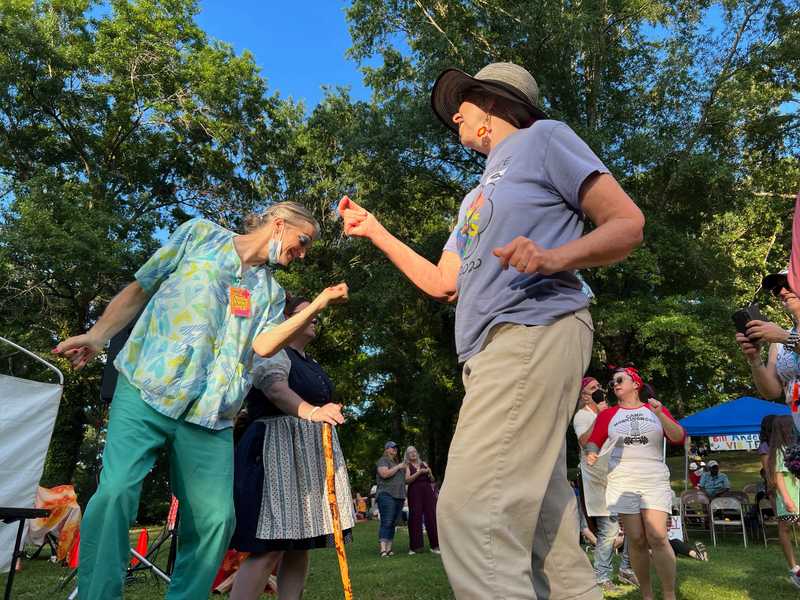Watch any individual lost in a dance routine — whether it's ballet, hip-hop, tap, ballroom, or salsa — and you'll notice the subtle combination of artistic expression and athleticism.
Dancers' ability to move freely is closely tied to their identity. For example, in 2013 professional dancer Wendy Whelan experienced an identity crisis when she sustained a hip injury (after over 3 decades of performance with her dance company) that required surgery.
Dance injuries can be so much more than just physically debilitating; they can also be emotionally devastating.
Wendy reports feeling terrified when her injury affected her ability to dance. She felt ashamed of the limp she had post-surgically and felt she had lost her primary mode of expression.
Thankfully, a bout of physical therapy helped her recover and ultimately conclude her ballet career on her own terms with one beautiful final performance. It also allowed her to smoothly transition to a new form of contemporary dance. For any dancer dealing with an injury, physical therapy is an invaluable tool to keep them immersed in doing what they love most — expressing themselves through movement.
Table of Contents
- What are Some Common Dance Injuries?
- Common Causes of Dance Injuries
- When to Seek Medical Advice
- How to Treat Dance Injuries
- How to Prevent Dance Injuries
- Spend More Time Dancing and Less Time Recovering
What are Some Common Dance Injuries?
A dance injury can result from acute trauma, overuse, or a combination of the two. Sustaining an injury is possible with any type of dance. Intense training routines and complex moves with dance forms like ballet and hip-hop lead to the highest risk.
Dancing can result in joint sprains, muscle strains, and muscle spasms, making it difficult to maintain a training regimen.
There are certain injuries that dancers are at a higher risk of sustaining. Let's review:
Ankle Sprains
An ankle sprain is one of the most common injuries seen in dancers. It may occur when there’s an abrupt change in direction or a misstep. Dancers are more likely to be hypermobile (extra flexible joints and tissues), which can increase their likelihood of a sprain if their dance mechanics are not optimized.
The loss of ankle stability from a sprain can make it feel impossible to do even the most basic of dance moves, affecting a dancer's ability to self-express via artful movement.
Other Common Lower Leg Overuse Injuries
- Achilles tendonitis: Inflammation of the tendon that connects the calf muscle and heel bone. Tendonitis can also occur in other body areas, including the hamstrings and hip flexors.
- Shin splints: Inflammation of the muscles, tendons, and bone tissue in the lower leg along the shin.
- Stress fractures: Compromised bone health of the shin (tibia), ankle or toes, resulting in microscopic cracks.
- Trigger toe (similar to trigger finger and turf toe): Each results in specific damage to the local tissues of the toe.
- Ankle impingement: Compression of the foot and ankle bones that causes pain — most common with ballet.
Hip Impingement
As Wendy Whelan experienced, hip impingement and labral tears are commonly seen in dancers, especially with turns and jumping. This occurs due to hip instability (typically "micro-instability"), causing the ball of the femur to catch on the edge of the hip socket while turning or extending.
Other Common Hip and Knee Injuries
- Snapping hip: Characterized by an audible "snapping" sensation while performing certain moves such as kicks or leaps.
- Hip bursitis: Inflammation of the fluid-filled sacs between the bones and soft tissue of the hip joint (the bursae).
- Sacroiliac (SI) joint dysfunction: Irritation and pain of the static joints that connect the spine to the pelvis (where your back dimples are located). (It is closely related to low back pain, as discussed below.)
- Patellofemoral pain and patellar tendinopathy: Also known as "jumper's knee," pain and inflammation occur at the front of the knee (patellar tendon and kneecap).
Low Back Pain
Chronic low back pain is common among all dance types. Most often, deficits in core strength, coordination, and spine mobility are the culprits. Back pain can lead to fear of movement and aggravation, affecting a dancer's training schedule and technique — exacerbating the issue further.
Acute Injuries
In addition to injury from chronic overuse, dancers can also sustain traumatic injuries from a fall, new move, or awkward mechanics, resulting in complications like concussion, fracture, ligament or muscle tears, or joint dislocation.
Common Causes of Dance Injuries
There are a variety of underlying issues that can contribute to a dance injury. For an injured dancer, understanding what caused their injury in the first place is vital for getting on track with a recovery plan and feeling empowered to continue dancing on their own terms.
The most common underlying causes of a dance injury include:
Lack of Recovery Time
The term "overuse" has been used several times in this article. And for a good reason. Dancers can push themselves too hard during training and rehearsals, leading to fatigue and injury.
Despite the temptation to keep pushing their limits (as is common with any passionate athlete), dancers should be proactive about giving their bodies rest and recovery time to help prevent injury.
A Sudden Increase in Training Volume or New Choreography
Dancers should progress slowly when increasing their training volume or learning new choreography. Sudden changes can lead to muscle fatigue and altered mechanics that strain local tissues.
It's important to give the body time to adjust to new movements and choreography before progressing too quickly.
Environmental Factors
Factors such as shoes, the temperature of the dance studio (too hot or cold), and the type of dance floor (hard vs. soft) can all influence how a dancer moves. For example, ballet flats are notoriously hard on the foot and ankle and require close attention to proper technique while performing.
Lifestyle Factors
Our bodies are subject to injury when other areas of our health are out of balance. For example, too much stress, a poor diet, eating disorders, and dysmenorrhea (lack of a monthly cycle in women) — all common with dancers — can compromise tissue health and increase the risk of injury.
Other Factors
Finally, previous injuries, faulty movement mechanics, and genetics (related to bone structure, alignment, and tissue flexibility) can all predispose a dancer to an injury.
When to Seek Medical Advice
You're probably used to a fair share of discomfort and pain as a dancer. But when is further intervention warranted? Let's review the following that warrants seeking medical care:
- Pain that wakes you up at night.
- Pain that gets worse with activity.
- Pain that is getting progressively worse.
- Pain that hasn't gone away with home treatment in one to two weeks.
- Pain that has been lingering for six weeks or more.
- Pain that affects your daily routine or dance routine.
- Pain that makes you feel uncertain or has you concerned.
How to Treat Dance Injuries
For dancers looking to reduce their downtime and get effective treatment as soon as possible, the evidence clearly supports physical therapy. For severe cases or traumatic injuries, you may need a physician's care for bracing, casts, or surgery (not common).
Physical therapy for dancers has been shown to minimize lost dance time and maximize outcomes, getting dancers back to doing what they love as soon as possible. You can start working with a CityPT physical therapist as soon as today without needing a physician referral.
Physical Therapy for Dancers
When working with a CityPT physical therapist, they will understand that dancing is a part of your identity. After discussing your goals, concerns, and lifestyle, they will complete a thorough physical examination. Then, they will develop a personalized treatment plan to address your specific needs. This typically includes the following:
- Education: Your physical therapist will answer all your questions and help you understand the true cause of your injury — most important you will feel seen and heard as you make a sustainable recovery.
- Pain management modalities: Short-term strategies for managing pain and other symptoms, such as ice, heat, ultrasound, and light therapy.
- Prescribed functional exercise: Stretching, strengthening, and biomechanical training to restore normal movement mechanics and reduce local tissue strain.
- Assessment of technique: Your physical therapist will also assess your technique and provide you with strategies to help reduce stress on the body.
- Manual therapy: Hands-on treatment to address soft tissue restrictions, pain, and joint mobility.
- Prevention: Exercises, strategies, and advice to help you prevent the recurrence of the injury.
How to Prevent Dance Injuries
Dance injuries can't always be prevented. Maintaining a balanced and regular physical training program is the most reliable way to prevent a dance injury or aggravation, which can later lead to arthritis (or other problems) if not well managed.
Injury prevention strategies should include the following:
- Design a well-rounded training program: This should include adequate active warm-up and cool-down.
- Biomechanical analysis: This includes a professional look at a dancer's posture, gait, joint range of motion, and muscle strength. Talk to your physical therapist.
- Strength training: Dancers should focus on developing coordinated muscles that protect their joints and tissues.
- Stretching: Appropriate stretching is essential for better mobility, strength, and flexibility (this will vary for each individual).
- Cross-training: Dancers should also participate in other forms of physical activity, such as pilates, yoga, and swimming, to supplement their dance training and give their bodies time for active recovery.
- Nutrition: Eating a balanced diet with all the necessary nutrients can help maintain healthy muscle tissue and reduce inflammation.
- Other lifestyle factors: Adequate sleep, stress management, addressing mental health issues, and avoiding excessive alcohol consumption are all key factors in injury prevention.
- Environmental factors: Being mindful of your footwear and practice space can also help reduce your injury risk.
Spend More Time Dancing and Less Time Recovering
Dealing with an injury can feel scary. For a dancer, it can feel like a loss of control over an activity they've spend so much time mastering. The right guidance can feel like a shining beacon of hope in an otherwise dark world.
Physical therapy is an effective tool for treating existing dance injuries and preventing them from happening in the first place. By taking a proactive approach to their health, dancers can effectively manage and prevent injuries, stay in peak physical shape, and keep doing the activity they love.
If you're looking for a physical therapist to help, schedule an appointment with a CityPT specialist today and get back to dancing confidently.
Before you go, please read our disclaimer. This blog is intended for informational purposes only. We are not providing legal or medical advice and this blog does not create a provider-patient relationship. Do not rely on our blog (or any blog) for medical information. Always seek the help of a qualified medical professional who has assessed you and understands your condition.

JayDee Vykoukal is an author, holistic health coach, mom blogger, and passionate Doctor of Physical Therapy. She loves teaching healthy living, writing about motherhood, traveling and spending quality time with her family.

JayDee Vykoukal is an author, holistic health coach, mom blogger, and passionate Doctor of Physical Therapy. She loves teaching healthy living, writing about motherhood, traveling and spending quality time with her family.


